Guitar tablature, commonly known as “guitar tabs,” is a revolutionary way for aspiring guitarists to quickly grasp and learn their favorite songs. Similar to standard music notation, guitar tabs visually represent the music, indicating notes, rhythm, and techniques. However, guitar tabs offer a significant advantage, especially for beginners: they show you precisely where to play those notes on the guitar fretboard.
This is incredibly helpful because, unlike many other instruments, the guitar allows you to play the same note in multiple locations. Learning How To Read Guitar Tabs is an invaluable skill for beginners, enabling you to start playing music immediately, even without prior knowledge of traditional music theory.
At guitarplayers.net, we believe in making guitar learning accessible and efficient. Guitar tabs are perfect for this, displaying both chords and single notes in an easy-to-understand format. Mastering guitar tabs eliminates complex music reading hurdles and allows you to dive straight into playing your favorite tunes. All you need is a basic understanding of your guitar strings and frets, and you’re ready to go!
If you’re eager to unlock the world of guitar tabs and discover how they can accelerate your learning journey, you’ve come to the right place. Let’s explore the essentials of reading guitar tabs and get you playing in no time.
WHAT ARE GUITAR TABS?
Guitar tablature is essentially a visual map of music for guitarists. A standard guitar tab is composed of six horizontal lines, each representing one of the six strings on a guitar. When you learn how to read guitar tabs, it’s crucial to understand this layout from top to bottom. The topmost line corresponds to the high E string (the thinnest string), followed by lines for the B, G, D, A, and low E strings (the thickest string).
This arrangement mirrors how you see the strings when looking down at your guitar in playing position. Think of guitar tablature as your personal roadmap to musical fluency, providing the quickest route to playing your favorite guitar songs.
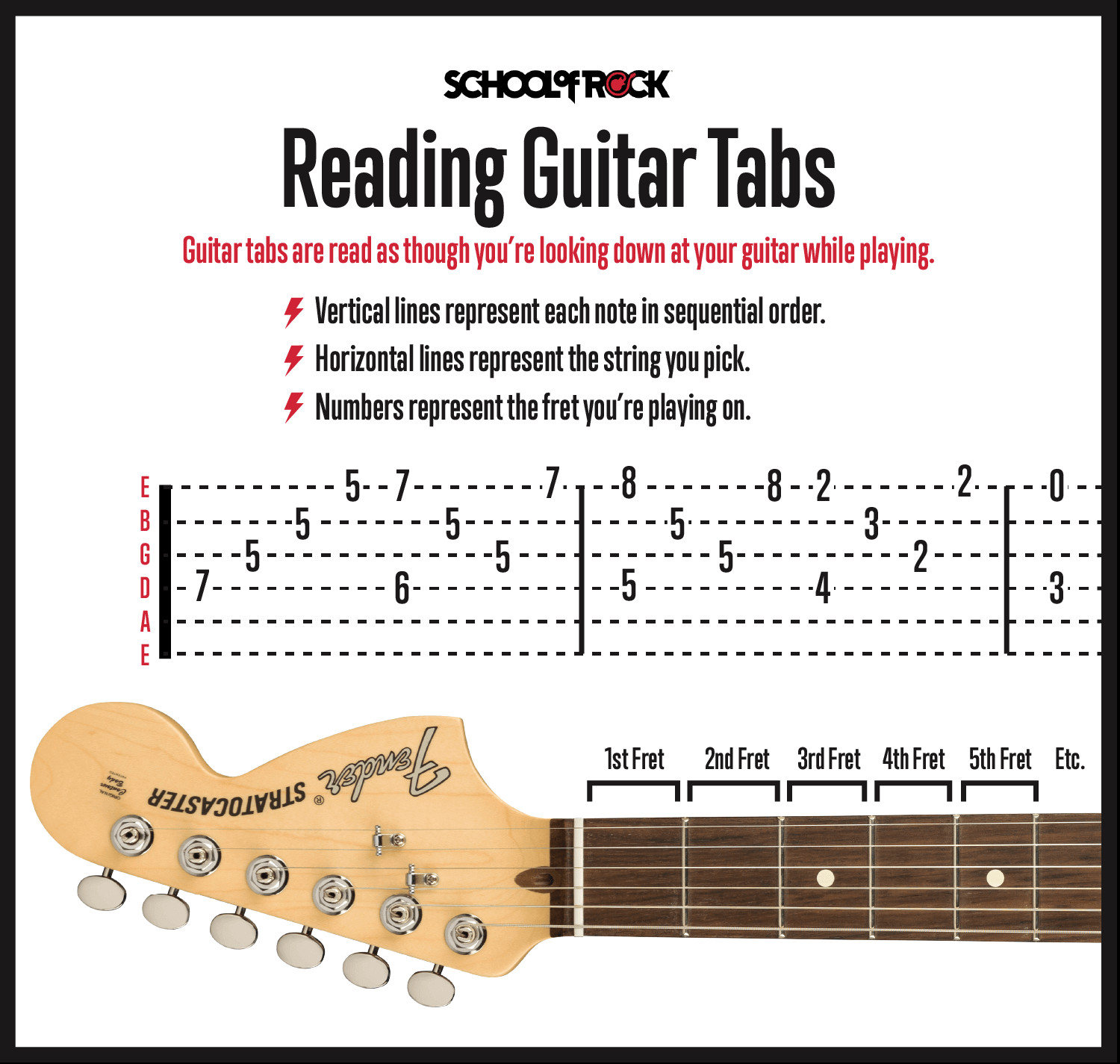 Guitar tablature diagram showing string and fret representation.
Guitar tablature diagram showing string and fret representation.
As you delve deeper into reading guitar tablature, you’ll notice numbers appearing on these lines. These numbers represent the frets on your guitar, the metal strips along the fretboard. Frets are numbered from 0 to 24 (or sometimes more), starting from the nut (closest to the headstock) down the guitar neck.
A “0” on a string indicates an open string, played without pressing down on any fret. A “1” means you should play the note at the first fret, “2” at the second fret, and so on. Understanding this numerical system is fundamental to how to read guitar tabs effectively: each number directly corresponds to a fret position.
HOW TO READ GUITAR TABS
Guitar tabs are read from left to right, just like standard text. The notes are presented in the order they are played in the song. When you see numbers stacked vertically on the tab, this signifies a chord. A chord is played by strumming all the indicated strings simultaneously. For beginners, guitar tab notation offers a more accessible entry point than standard notation because it clearly shows you which notes to play for a chord and, crucially, where to find them on the guitar.
WHAT DO I NEED TO KNOW TO READ GUITAR TABS?
To successfully learn how to read guitar tabs, beginners should first become familiar with the names and order of the 6 guitar strings and the location of the frets. This foundational knowledge will enable you to quickly locate the correct notes on your guitar as guided by the tab.
UNDERSTANDING THE GUITAR TAB STAFF
The guitar tab staff visually resembles the staff used in standard music notation. The key difference is that the lines in guitar tab represent the 6 guitar strings, not musical pitches as in standard notation.
The top line always indicates the high E string, and the bottom line represents the low E string. This direct string representation makes learning how to read guitar tabs straightforward for beginners. Typically, a tab staff will also be labeled “TAB” to avoid any confusion with standard music notation.
UNDERSTANDING GUITAR FRETS
Guitar frets are the thin metal strips embedded in the fretboard, running perpendicular to the strings. They are essential for changing the pitch of a string.
Most guitars feature between 19 and 24 frets. The distance between each fret represents one semitone or half step. Within each octave, there are 12 semitones (or frets). To help navigate the fretboard, most guitars have fret markers – dots or inlays – usually positioned at the 3rd, 5th, 7th, 9th, and 12th frets. These markers are invaluable visual aids for quickly identifying fret positions while playing and learning how to read guitar tabs.
Remember, in guitar tabs, numbers denote fretted strings, while “0” signifies an open string. Playing an open string means plucking or picking the string without pressing down on any fret, allowing it to vibrate freely.
UNDERSTANDING GUITAR TAB CHORDS
Guitar tabs don’t use special symbols for chords, but chords are easily identifiable by their vertical arrangement. When several numbers are aligned vertically in a tab, they are intended to be played together as a chord. Even if a chord is arpeggiated – meaning the notes of the chord are played individually rather than strummed – it will still be represented in the tab, but as a sequence of single notes played in succession.
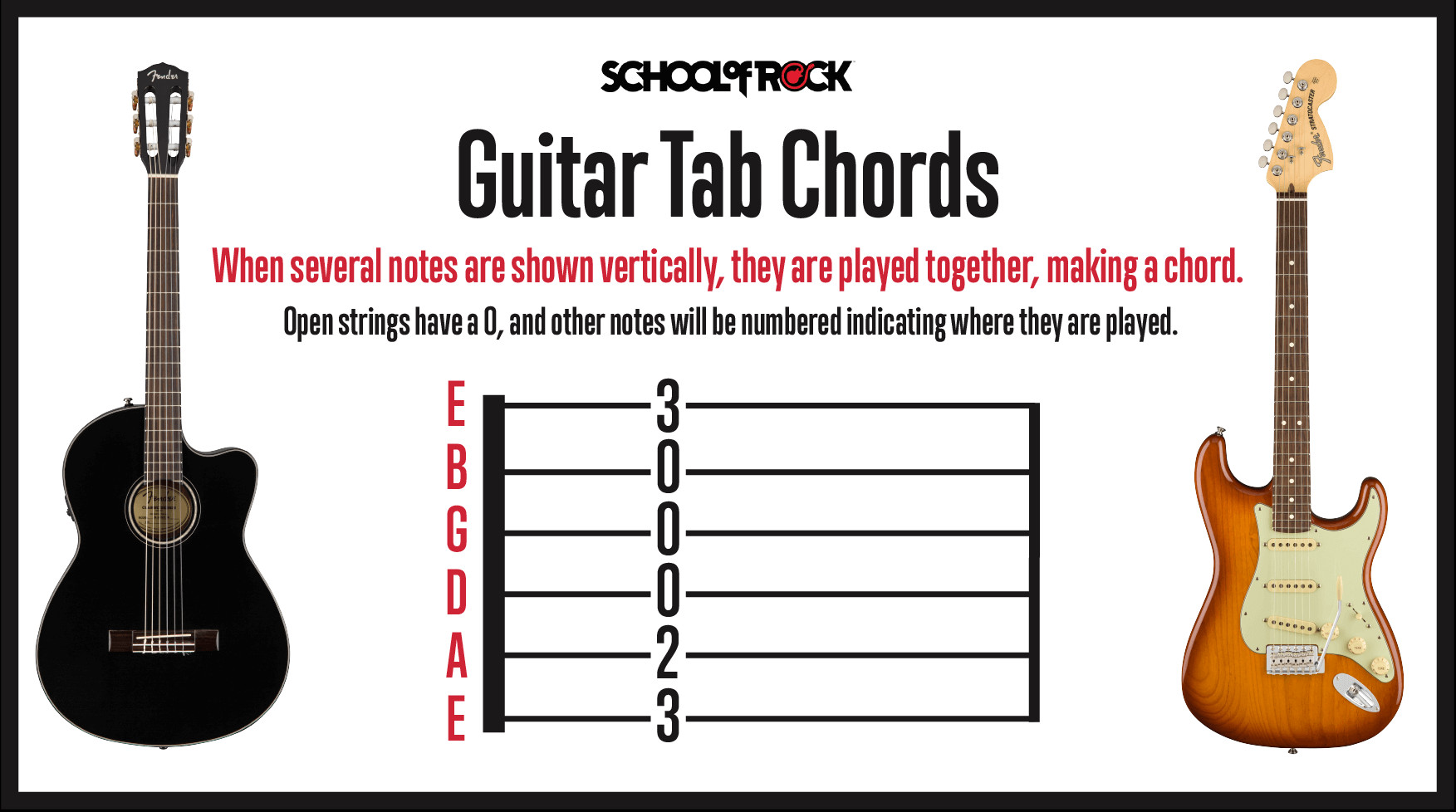 Example of guitar tab chords with vertically aligned numbers.
Example of guitar tab chords with vertically aligned numbers.
UNDERSTANDING GUITAR TAB RIFFS
Riffs, a cornerstone of many rock songs, are typically combinations of single notes and partial chords, like power chords. When learning how to read guitar tabs for riffs, the basic rule applies: vertically aligned notes are played simultaneously. This consistency makes learning riffs from tabs both quick and intuitive.
GUITAR TABS VS. CHORD CHARTS
Guitar tabs and chord charts serve different but complementary purposes. A chord chart is a diagram that visually represents the guitar fretboard and indicates where to place your fingers to form a chord. Chord charts often include finger numbers to guide your hand positioning. They are frequently placed above song lyrics to show chord changes.
Chord charts usually depict only the 3 or 4 core notes that constitute a particular chord. However, a full song arrangement might include single note lines, embellishments outside the basic chord tones, or arpeggios, none of which are detailed in a standard chord chart. For this reason, chord charts are often used alongside guitar tabs. They help beginner guitarists transition from basic chord strumming to playing more complete and nuanced song arrangements.
UNDERSTANDING FINGERS AND NUMBERS
Guitar tablature is linear, representing music sequentially, while chord charts offer a static snapshot of the fretboard for a specific chord. Chord charts use a numbering system to indicate which finger should fret each string. The fingers of your fretting hand are numbered: 1 for the index finger, 2 for the middle finger, 3 for the ring finger, and 4 for the pinky finger.
This finger numbering is distinct from tabs, where numbers denote fret positions, not finger assignments. Chord charts are often included with beginner guitar tabs to provide guidance on hand positioning, especially when learning basic chords.
HOW TO READ GUITAR TAB SYMBOLS
Beyond lines and numbers, guitar tabs use various symbols to indicate specific playing techniques. Understanding these symbols is crucial for accurately interpreting tabs and adding authenticity to your playing. Mastering how to read guitar tabs symbols will significantly enhance your ability to learn diverse guitar styles and techniques.
Before you start playing, always ensure your guitar is properly tuned. Consistent tuning is essential for your guitar to sound right, regardless of the techniques you employ.
MUTING GUITAR NOTES
Muting is a fundamental technique, especially in genres like Rock, Metal, Punk, and Alternative. Different muting techniques are used to add rhythmic texture and character to music.
HOW TO MUTE GUITAR NOTES
Muting can be achieved with either your picking hand or your fretting hand, or a combination of both. It introduces dynamics to your playing and is a valuable skill for refining your sound. Many songs use muting in verses to create contrast with unmuted choruses or hooks.
Experienced guitarists often use muting intuitively, particularly in live performance settings. At stage volumes, muting helps eliminate unwanted noise and feedback while playing.
GUITAR TECHNIQUE: PALM MUTING
Palm muting is among the most frequently used guitar techniques in rock music. It involves resting the palm of your picking hand lightly on the strings near the bridge while picking. Heavy palm muting creates a tight, percussive sound, while lighter palm muting allows notes to ring out with some sustain. In guitar tabs, palm muting sections are usually indicated by “P.M.” written above the tab staff.
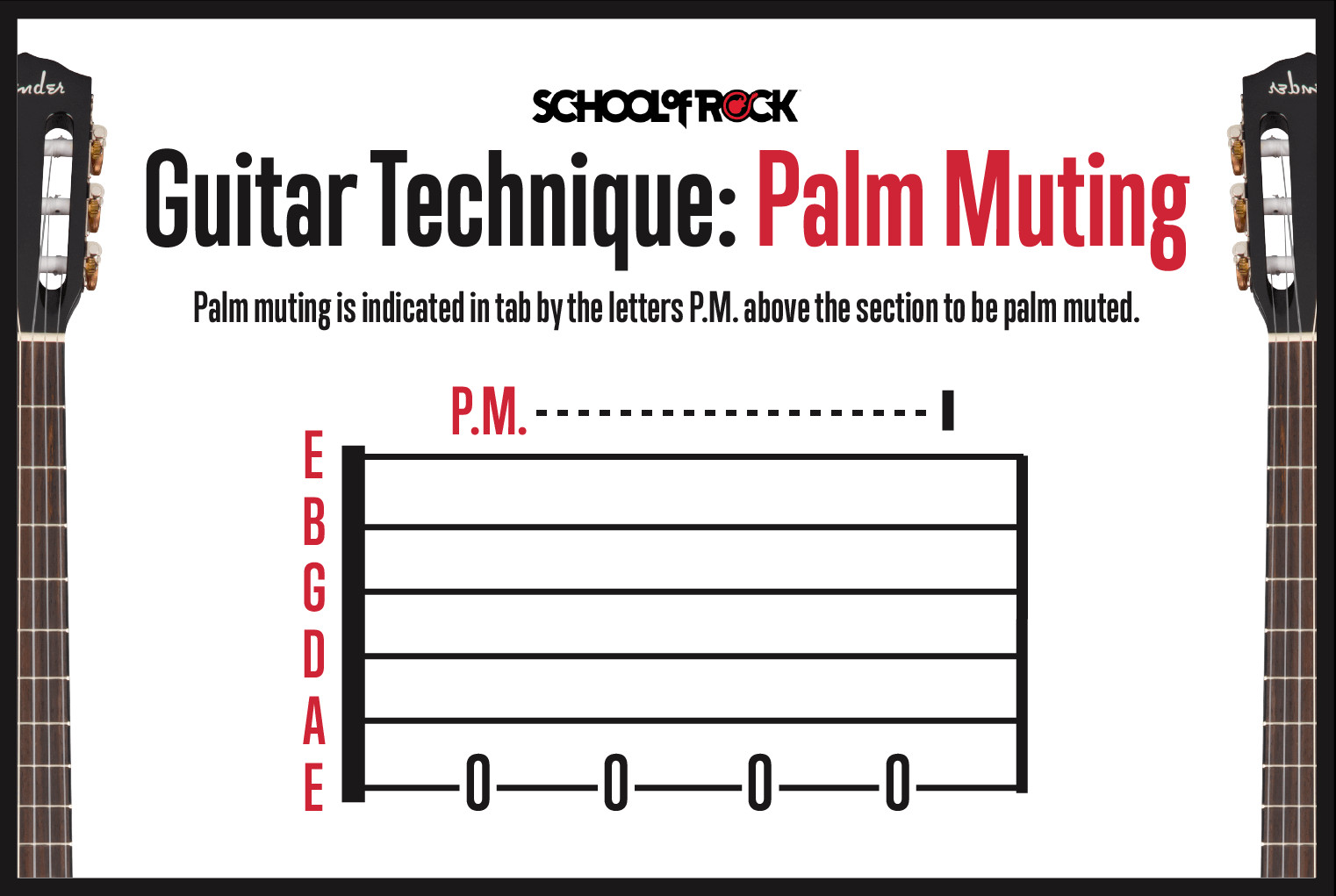 Demonstration of palm muting technique on guitar.
Demonstration of palm muting technique on guitar.
GUITAR TECHNIQUE: MUTED NOTES
Muted notes, sometimes called dead notes, are distinct from palm muting. This technique involves using your fretting hand to lightly dampen the strings instead of pressing them down fully to produce a clear pitch. In guitar tablature, muted notes are represented by an “X” in place of a fret number. You still pick the string, but it produces a percussive, muted sound rather than a distinct note.
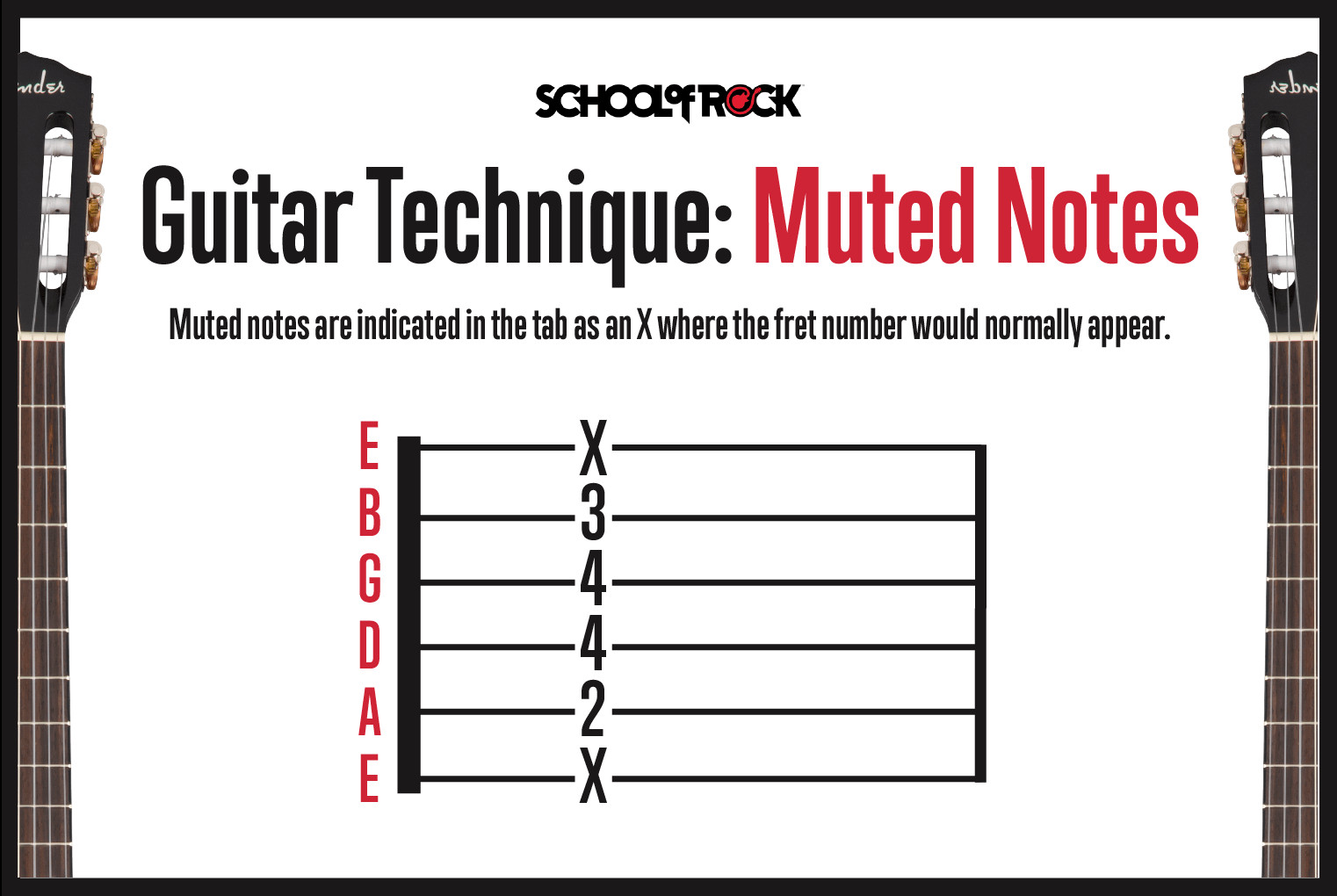 Guitar tab example showing 'X' symbol for muted notes.
Guitar tab example showing 'X' symbol for muted notes.
BENDING GUITAR STRINGS
String bending is a technique that adds expressive, vocal-like qualities to guitar playing. In guitar tabs, bends are indicated by a curved arrow over the note to be bent. The arrow may specify “½” or “full,” indicating a half step (one fret) or full step (two frets) bend, respectively. These target pitches are often referred to as “target notes.”
HOW TO BEND GUITAR STRINGS
Bending involves pushing or pulling the string sideways across the fretboard, rather than pressing straight down. For most strings except the low E, you typically push upwards towards the ceiling. The low E string is usually bent downwards towards the floor. The key to a good bend is applying smooth, consistent pressure throughout the bend.
GUITAR TECHNIQUE: BENDING GUITAR STRINGS
Most string bends are executed using 2 or 3 fingers. The primary fretting finger (often the ring finger) performs the bend, while the middle and index fingers provide support and strength. This multi-finger approach makes bending smoother, easier to control, and improves pitch accuracy.
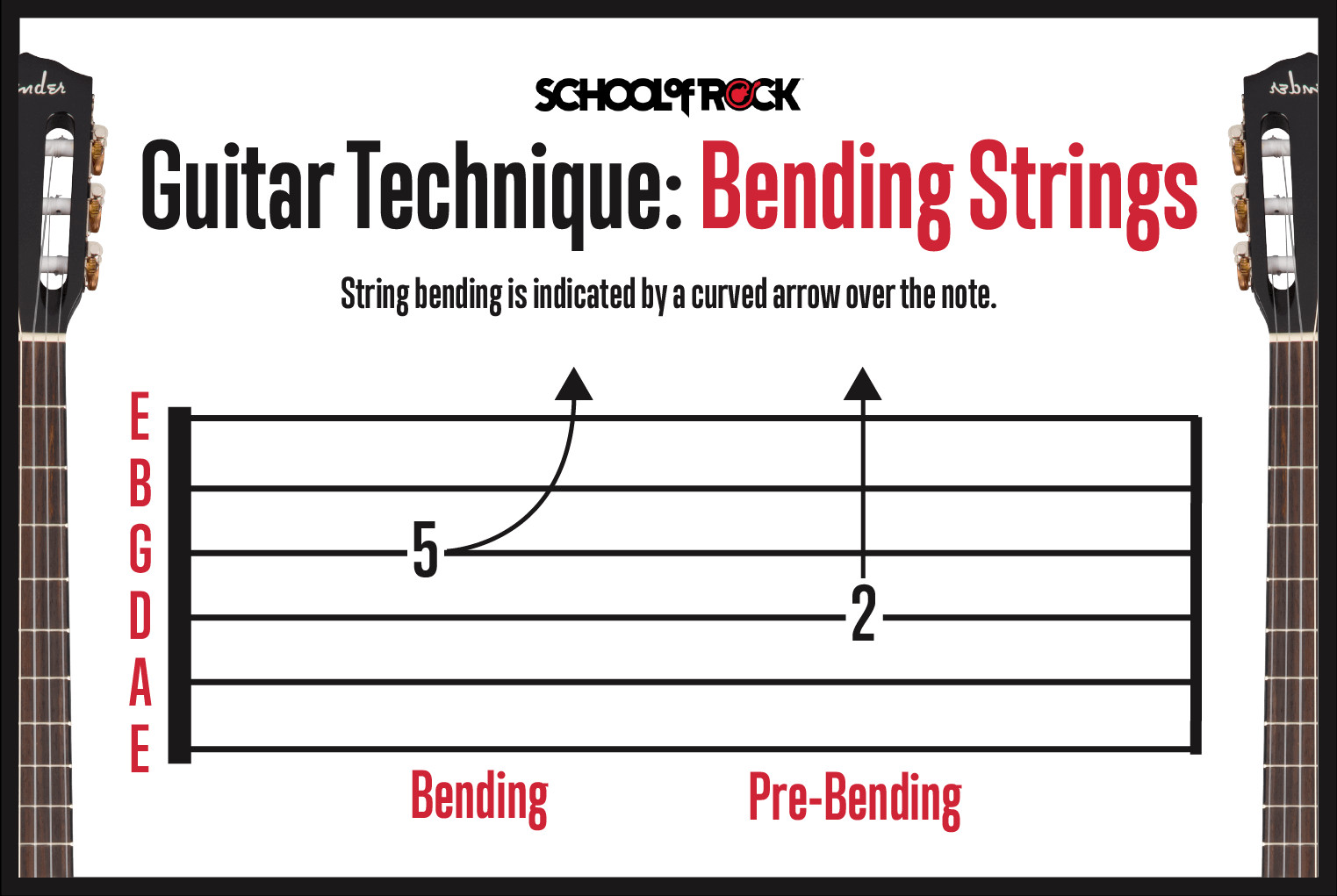 Visual guide on how to bend guitar strings effectively.
Visual guide on how to bend guitar strings effectively.
GUITAR TECHNIQUE: PRE-BENDING GUITAR STRINGS
When learning how to read guitar tabs, you might encounter pre-bends. A pre-bend involves bending the string to the target pitch before picking the note. The tab notation for a pre-bend includes a vertical arrow pointing upwards (with bend range indicated – full, ½, etc.), followed by a curved arrow pointing downwards. After picking the pre-bent note, the string is then released, returning to the original fretted pitch. Pre-bends can resolve back to the original note or bend further upwards to another target pitch.
SLIDING GUITAR NOTES
Sliding is another expressive technique that allows you to smoothly transition between notes. You can slide up to a higher note or down to a lower note. Sliding differs from bending because you maintain finger pressure on the string while moving your finger along the fretboard to the next note.
GUITAR TECHNIQUE: SLIDE UP
In guitar tabs, a slide up is shown by a line connecting the starting note to the ending note. If the slide is to a higher pitched note, the line often slants slightly upwards.
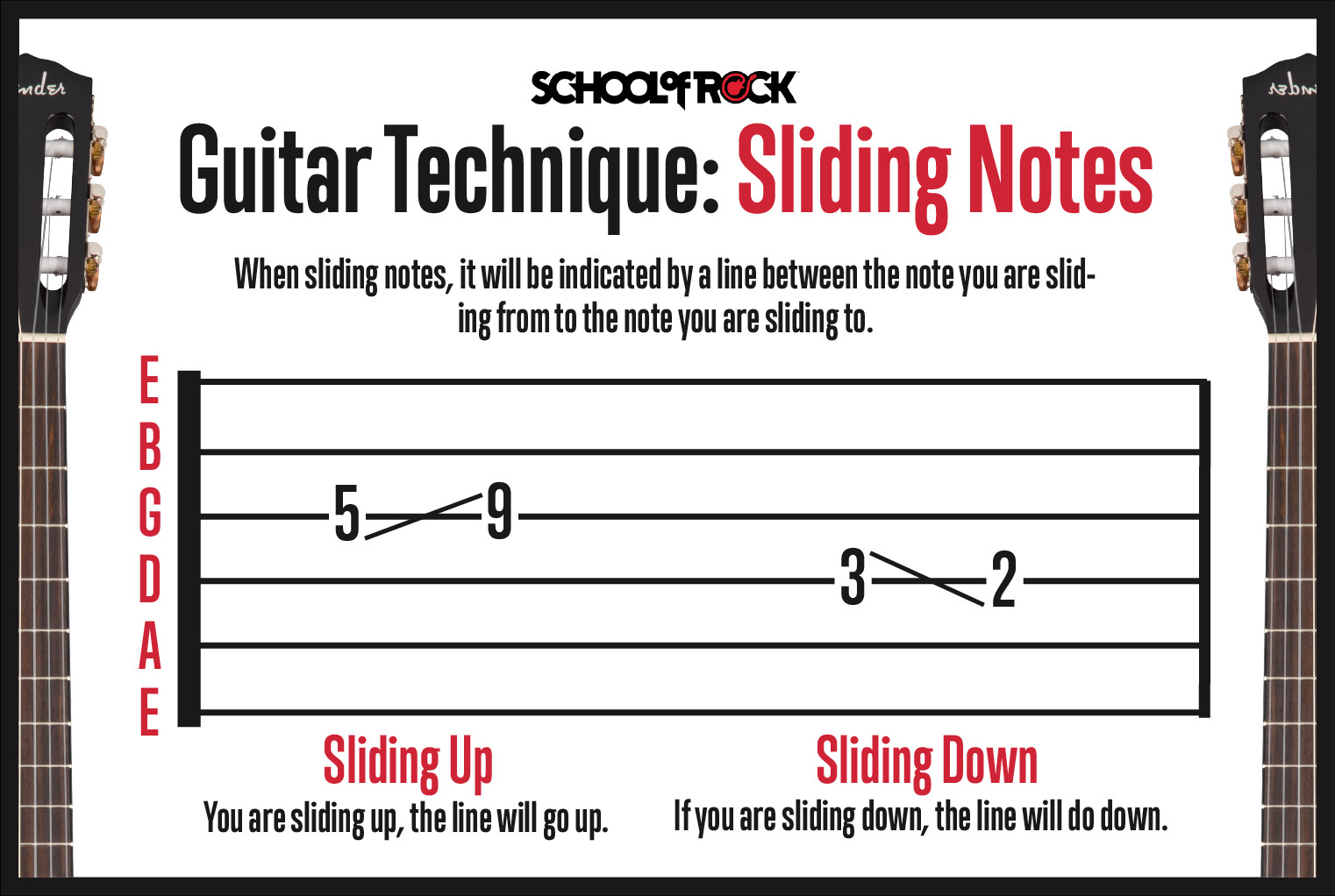 Guitar tab illustration of sliding notes technique.
Guitar tab illustration of sliding notes technique.
GUITAR TECHNIQUE: SLIDE DOWN
Conversely, a slide down is also indicated by a line between notes. If the slide is to a lower pitched note, the line may slant slightly downwards.
PLAYING HAMMER-ONS ON THE GUITAR
A hammer-on is a guitar technique where you produce a note by “hammering” your fretting finger onto the string behind a fret, without picking the string. You can hammer-on from an open string or from a previously fretted note, and the resulting note will always be higher in pitch. In guitar tabs, hammer-ons are indicated by the letter “H” and a curved arc connecting either an open string “0” to the hammered-on note or connecting two fretted notes.
HOW TO PLAY HAMMER-ONS ON THE GUITAR
To execute a hammer-on, strike the string with your fretting finger with enough force to sound a clear note. Achieving a clean, strong hammer-on takes practice. It’s often easier to learn on an electric guitar at a moderate volume. Start by trying a hammer-on from an open low E string to the third fret. Practice on different strings and between various fret combinations.
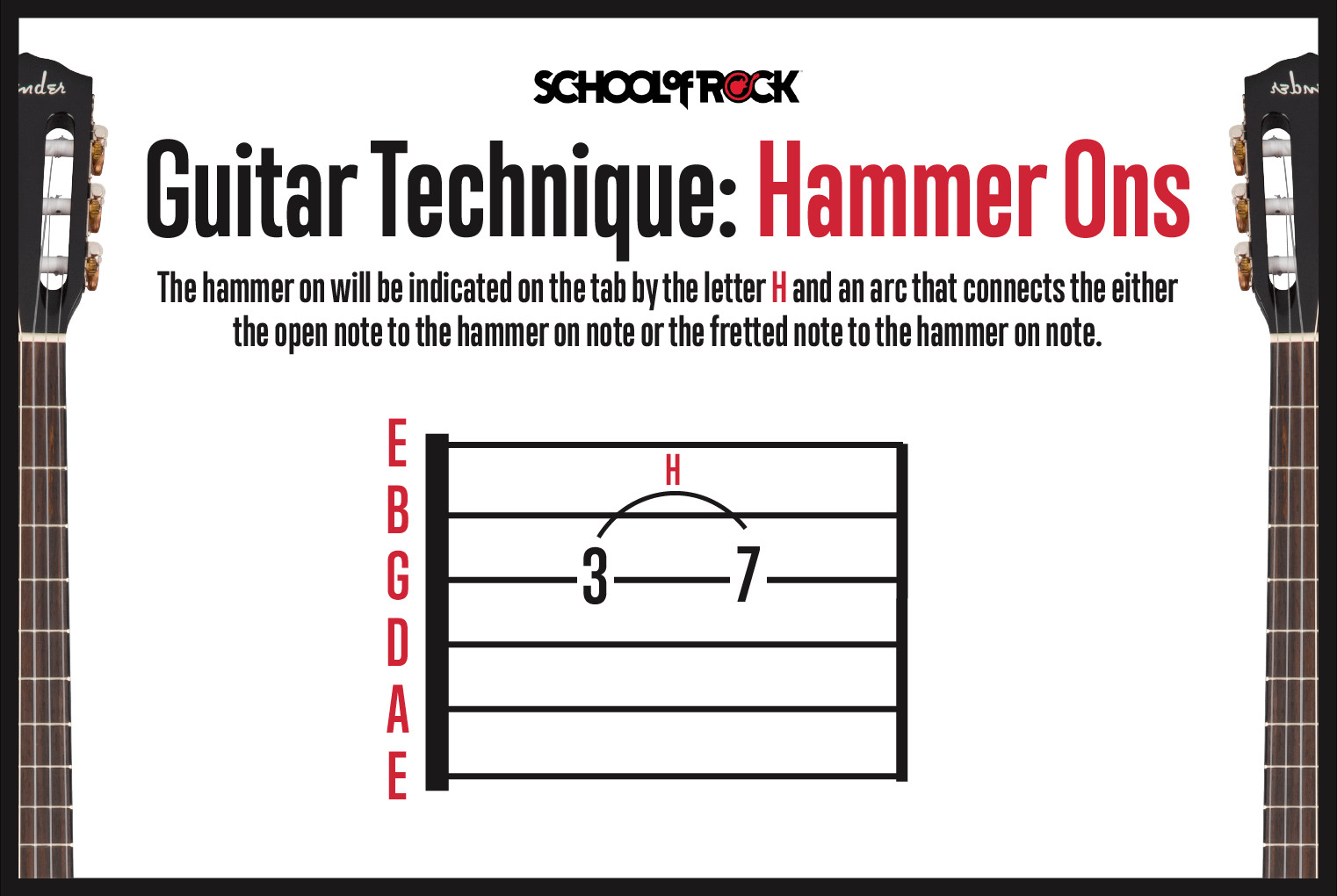 Demonstrating hammer-on technique on the guitar fretboard.
Demonstrating hammer-on technique on the guitar fretboard.
PLAYING PULL-OFFS ON the GUITAR
Pull-offs are the opposite of hammer-ons. Instead of hammering onto a string, you “pull off” a fretted note to sound either an open string or a lower fretted note. In guitar tabs, pull-offs are shown with the letter “P” and an arc connecting the pulled-off note to the resulting lower note (either open or fretted).
HOW TO PLAY PULL-OFFS ON the GUITAR
To perform a pull-off, start with a fretted note. Then, using a downward or sideways flicking motion of your fretting finger, pull the finger off the string. This action plucks the string, causing it to vibrate and sound a note – either an open string or a note fretted by another finger. When executing pull-offs, ensure you “grab” enough of the string with your fingertip to produce a clear sound.
Hammer-ons and pull-offs can be combined in alternating sequences, often referred to as trills, creating rapid, fluid passages.
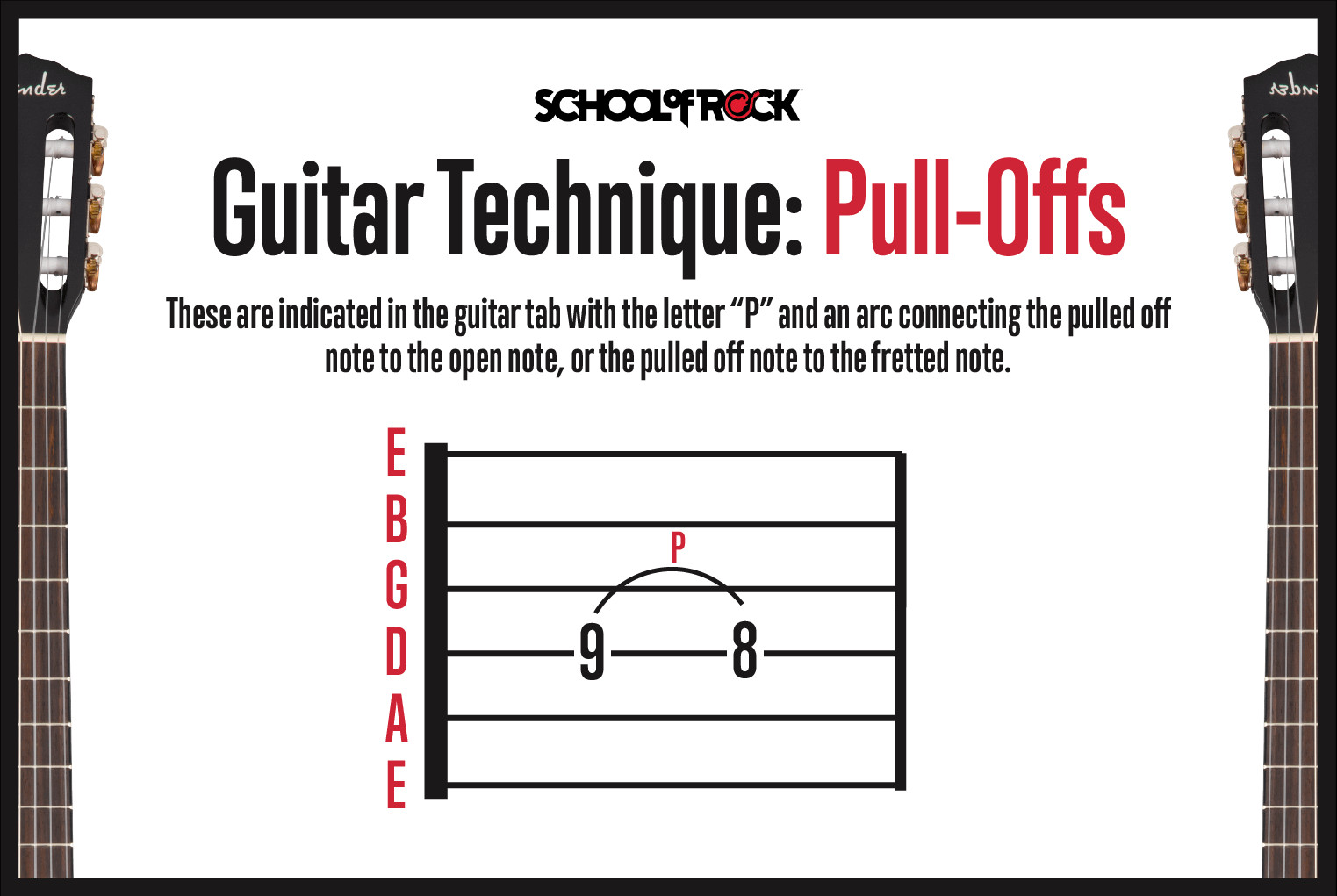 Visual representation of pull-off technique in guitar playing.
Visual representation of pull-off technique in guitar playing.
PLAYING VIBRATO ON THE GUITAR
Vibrato is a technique that adds warmth and expression to sustained notes. It involves repeatedly and subtly bending a note and releasing it back to its original pitch without lifting your finger from the fret. In guitar tabs, vibrato is represented by a zig-zag line above the tab staff. The length of this zig-zag line typically indicates the duration of the vibrato. Longer lines suggest a longer vibrato application.
HOW TO PLAY VIBRATO ON the GUITAR
Vibrato is similar to bending but involves much smaller pitch variations. You can apply vibrato using a single finger or by using a primary finger supported by others. Start practicing with a slow, smooth vibrato, and then experiment with varying speeds to achieve different expressive effects. Like bending, vibrato is a highly personal technique; each guitarist develops a unique vibrato style.
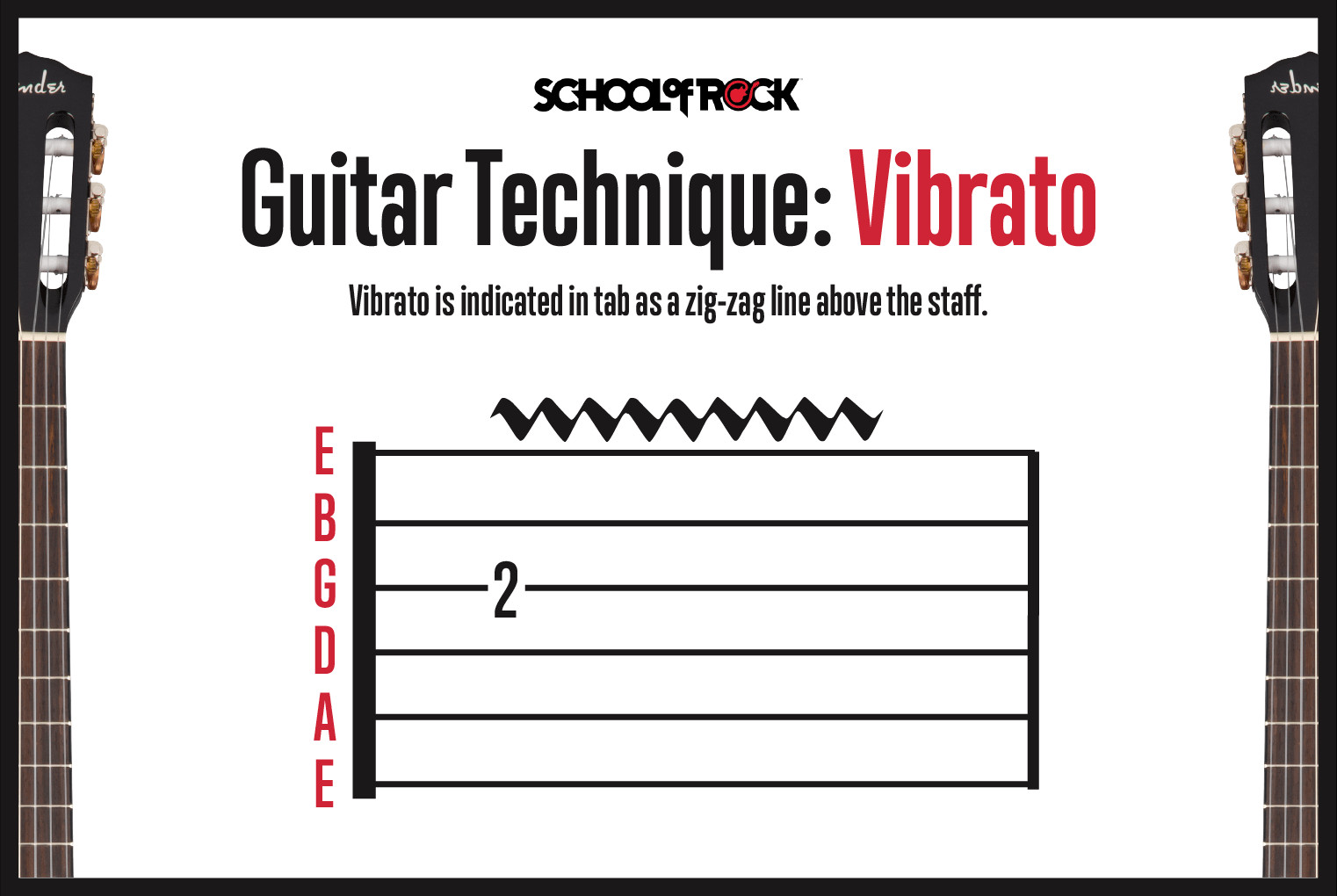 Example of vibrato notation in guitar tablature.
Example of vibrato notation in guitar tablature.
TAPPING GUITAR
Tapping is an advanced technique where you fret notes with your regular fretting hand and also “tap” notes on the fretboard using a finger from your picking hand. The tapping action of your picking hand is essentially a variation of a hammer-on. In guitar tabs, tapping is notated by a “T” above the tapped note.
HOW TO FINGER TAP GUITAR
Tapping was popularized by Eddie Van Halen, although the technique has roots in classical guitar. To finger tap, fret a note with your fretting hand, then use the index finger of your picking hand to sharply tap a higher fret on the same string.
Finger tapping is akin to a hammer-on, but instead of using a finger from your fretting hand, you use a finger from your picking hand. This allows you to play notes across wide intervals that would be impossible to reach with just your fretting hand. Playing with overdrive or distortion enhances the clarity and sustain of tapped notes, making the technique easier to execute and sound more effective. Tapping also enables very fast playing because you are effectively using both hands to fret notes.
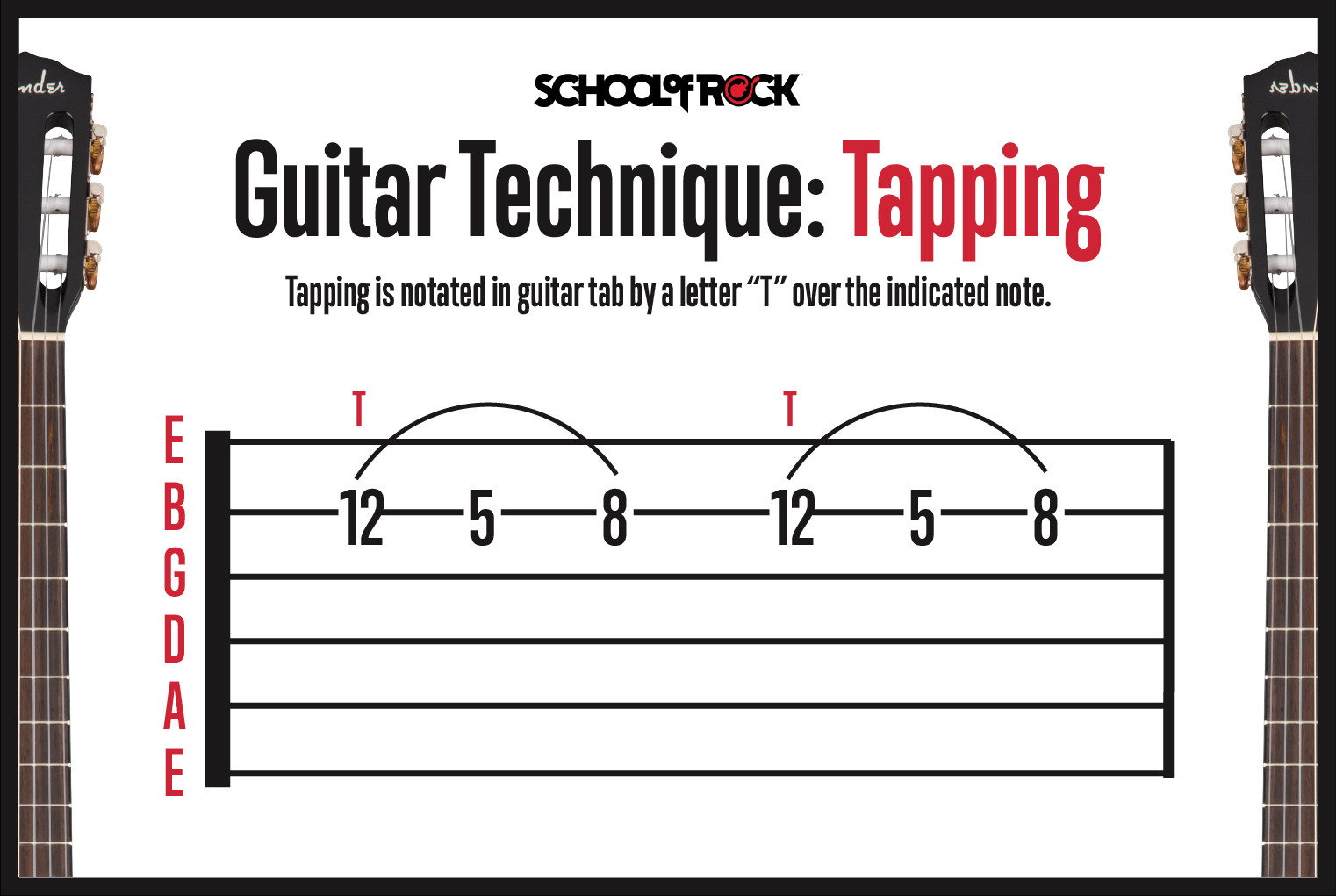 Illustration of two-handed tapping technique on electric guitar.
Illustration of two-handed tapping technique on electric guitar.
GUITAR TECHNIQUE: TWO-HANDED TAPPING
Two-handed tapping extends the tapping concept further. It involves both the fretting hand and the picking hand independently tapping notes, without traditional picking. In some applications of two-handed tapping, the fretting hand might tap bass notes while the picking hand taps melody or lead lines, creating complex textures.
STRUMMING GUITAR NOTES
When strumming chords, you’ll use two primary strumming directions: downstrokes and upstrokes.
Downstrokes are played from the lower (bass) strings towards the higher (treble) strings in a downward motion of your pick or strumming hand. In guitar tabs, downstrokes are represented by a symbol resembling a thick horizontal line with two short vertical “legs” pointing downwards on either side.
Upstrokes are the opposite, played from the higher strings towards the lower strings using an upward motion. In guitar tablature, upstrokes are notated by a “V” shaped symbol placed above the strummed chord or note.
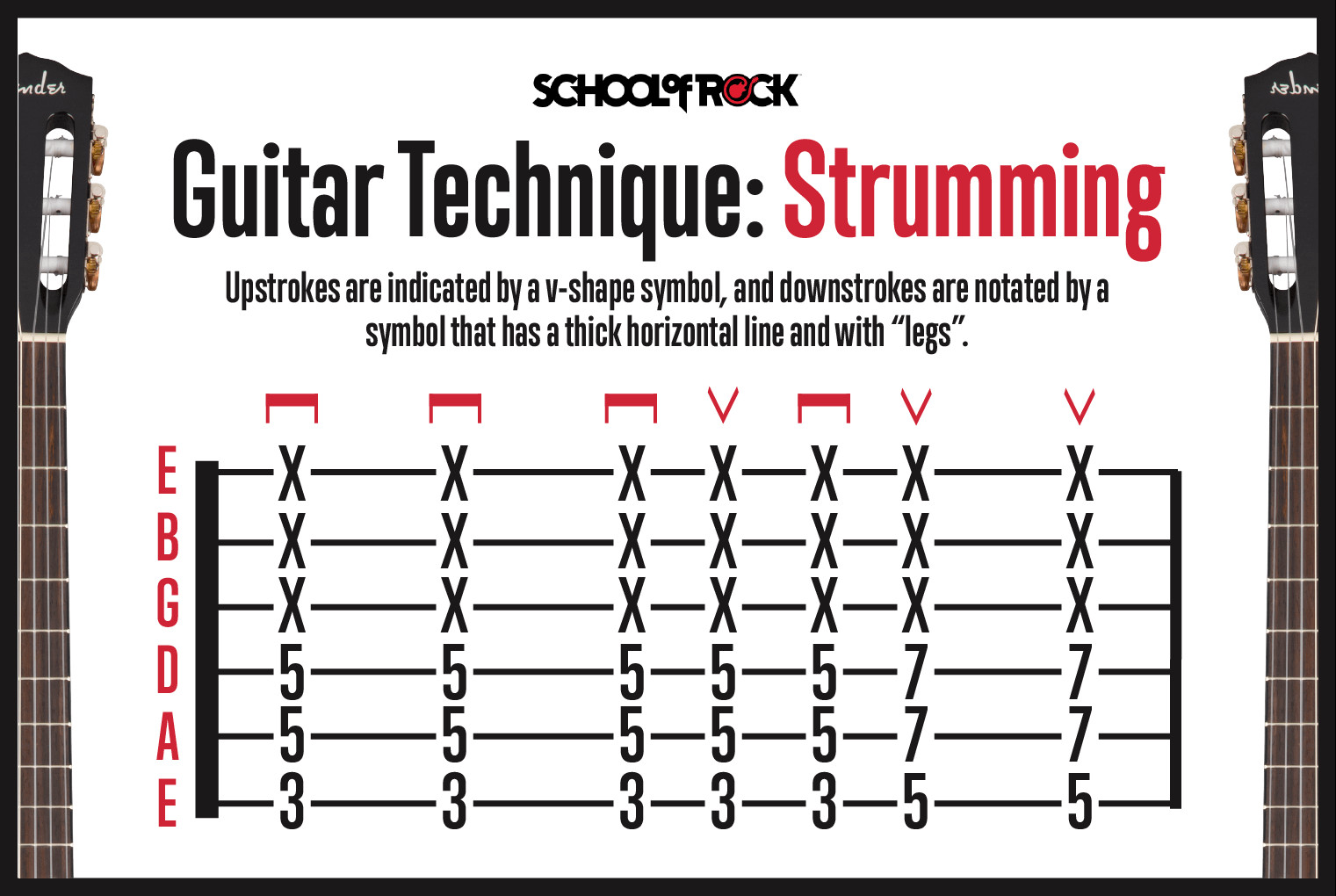 Guitar tab symbols for downstrokes and upstrokes.
Guitar tab symbols for downstrokes and upstrokes.
HOW TO STRUM GUITAR NOTES
Strumming patterns vary greatly depending on the song’s rhythm and style. You can use a continuous down-up strumming pattern or combine downstrokes and upstrokes in countless rhythmic variations. For songs with an eighth-note rhythm, a common count is “one-and-two-and-three-and-four-and.” Many songs employ alternating downstrokes and upstrokes in an eighth-note rhythm, with downstrokes falling on the numbered beats (1, 2, 3, 4) and upstrokes on the “ands.”
GUITAR TECHNIQUE: PLAYING DOWNSTROKES AND UPSTROKES
The downstroke and upstroke notation applies even when playing single notes in guitar tabs. A downstroke is indicated by the horizontal bar symbol with downward “legs,” signifying a downward pick motion. Conversely, an upstroke, marked by a “V,” indicates an upward pick motion.
READY TO LEARN OTHER GUITAR TECHNIQUES?
Now that you understand how to read guitar tabs and the various techniques they represent, you’re well-equipped to start playing a vast repertoire of music. From beginner basics to advanced techniques, guitarplayers.net is committed to helping guitarists of all levels reach their full potential. From basic strumming to complex tapping, our resources provide the knowledge and guidance you need to master your favorite guitar songs.
Ready to find guitar tabs and start playing? Whether you’re looking for easy songs for beginners or challenging pieces for advanced players, guitarplayers.net has you covered. Explore our extensive collection of high-quality guitar tabs and take your playing to the next level!
Ready to explore more guitar techniques and songs? Dive deeper into guitar playing with our comprehensive Guitar Buying Guide and expand your musical journey!
